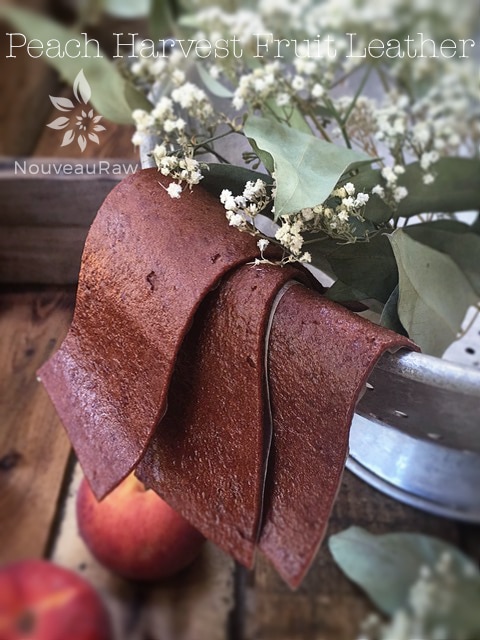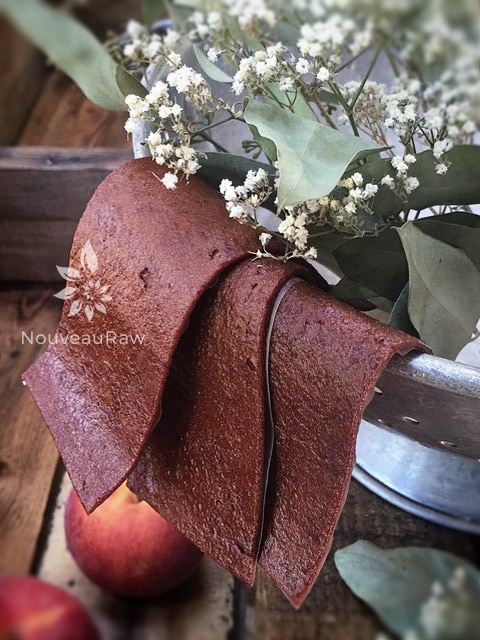Peach Harvest Fruit Leather

 Add to favorites
Add to favorites

~ raw, vegan, gluten-free, nut-free ~
Sweeteners are always an area of controversy. I have readers who send me emails questioning some of the sweeteners (raw agave, raw honey, dates, maple syrup, etc. ) that I use in my recipes.
I too find it overwhelming as to all the information that you can find that supports and degrades each and every one of them. So, I stand on my firm belief… make the best possible choice with your knowledge and use it in moderation, the sweetener that is, not your knowledge.
I chose to use real organic maple syrup in this recipe because of the flavor profile that it offers. For some reason, the thought of peaches and maple syrup sounded so warm and yummy in my mind.
So, I thought I would share some of the good things that I have read about it. This viscous amber liquid with its characteristic earthy sweet taste is made from the sap of the sugar, black or red maple tree.
- It’s an antioxidant powerhouse. Researchers at the University of Rhode Island found that maple syrup is filled with anti-inflammatory and antioxidant compounds that may help prevent several chronic and inflammatory diseases like diabetes, cancer, osteoporosis, and Alzheimer’s. It also comes packed with phenolics — the beneficial antioxidant compounds in maple syrup — that may help diabetics keep their blood sugar levels balanced since phenolics inhibit the enzymes that are involved in the conversion of carbohydrates to sugar.
- It settles digestion issues. Try swapping out sugar in baked-good recipes for maple syrup, and you may find that the usual gas and bloating you normally experience after consuming processed sweeteners is no longer an issue. If you do replace sugar with maple syrup, just be sure to reduce the amount of liquid the recipe calls for by about a half-cup.
- It helps with muscle recovery. Real maple syrup is an excellent source of manganese, which helps repair muscle and cell damage; it also keeps bones strong and blood sugar levels normal.
- It is filled with important nutrients. Maple syrup contains essential nutrients like zinc, iron, calcium, and potassium. Zinc not only supports reproductive health, but it also helps to keep your white blood cells up, which assist in the protection against colds and viruses.
As sweet as all of this sounds, keep in mind that at the end of the day, maple syrup is still just liquid sugar, so regardless of its health benefits, be sure to use maple syrup in moderation.
 Ingredients:
Ingredients:
yields 3 1/4 cups batter
- 5 cups chopped, organic peaches, peeled
- 2 Tbsp chia seeds, ground in spice grinder
- 2 Tbsp pure maple syrup
- 1 tsp ground Ceylon cinnamon
- 1/4 tsp maple flavoring, alcohol-free
Preparation:
- Select RIPE or slightly overripe peaches that have reached a peak in color, texture, and flavor.
- Prepare the peaches; wash, dry, peel, remove stems, and stones.
- Puree the fruit, ground chia, maple syrup, cinnamon, and maple flavoring in the blender or food processor until smooth. Taste and sweeten if needed. Keep in mind that flavors will intensify as they dehydrate. When adding a sweetener do so a little at a time, and reblend, tasting until it is at the desired taste. It is best to use a liquid type sweetener. Don’t use a granulated sugar because it tends to change the texture of the finished fruit leather.
- Allow the puree to sit for 10 minutes, so the chia has time to thicken the puree.
- Spread the fruit puree on teflex sheets that come with your dehydrator. Pour the puree to create an even depth of 1/8 to 1/4 inch. If you don’t have teflex sheets for the trays, you can line your trays with plastic wrap or parchment paper. Do not use wax paper or aluminum foil.
- Lightly coat the food dehydrator plastic sheets or wrap with a cooking spray, I use coconut oil that comes in a spray.
- When spreading the puree on the liner, allow about an inch of space between the mixture and the outside edge. The fruit leather mixture will spread out as it dries, so it needs a little room to allow for this expansion.
- Be sure to spread the puree evenly on your drying tray. When spreading the puree mixture, try tilting and shaking the tray to help it distribute more evenly. Also, it is a good idea to rotate your trays throughout the drying period. This will help assure that the leathers dry evenly.
- Dehydrate the fruit leather at 145 degrees (F) for 1 hour, reduce temp to 115 degrees (F) and continue drying for about 16 (+/-) hours. The finished consistency should be pliable and easy to roll.
- Check for dark spots on top of the fruit leather. If dark spots can be seen it is a sign that the fruit leather is not completely dry.
- Press down on the fruit leather with a finger. If no indentation is visible or if the fruit leather is no longer tacky to the touch, the fruit leather is dry and can be removed from the dehydrator.
- Peel the leather from the dehydrator trays or parchment paper. If the fruit leather peels away easily and holds its shape after peeling, it is dry. If the fruit leather is still sticking or loses its shape after peeling, it needs further drying.
- Under-dried fruit leather will not keep; it will mold. Over-dried fruit leather will become hard and crack, although it will still be edible and will keep for a long time
- Storage: To store the finished fruit leather…
- Allow the leather to cool before wrapping up to avoid moisture from forming, thus giving it a breeding ground for molds.
- Roll them up and wrap them tightly with plastic wrap. Click (here) to see photos of how I wrap them.
- Place in an air-tight container, and store in a dry, dark place. (Light will cause the fruit leather to discolor.)
- The fruit leather will keep at room temperature for one month, or in a freezer for up to one year.
Culinary Explanations:
- Why do I start the dehydrator at 145 degrees (F)? Click (here) to learn the reason behind this.
- When working with fresh ingredients, it is important to taste test as you build a recipe. Learn why (here).
- Don’t own a dehydrator? Learn how to use your oven (here). I do however truly believe that it is a worthwhile investment. Click (here) to learn what I use.
© AmieSue.com
Tags: Dairy Free, Gluten Free, Nut Free, Refined Sugar Free, Soy Free, sugar free, Vegan



 Add to favorites
Add to favorites
 Ingredients:
Ingredients:
Hi Amie Sue. I have a great deal of frozen fruit lying around. Can I defrost and use frozen fruit for making fruit leather?
Yes, I have used frozen in the past Stephanie with great success. Have a great day! amie sue
Hi Amie Sue,
Thanks for all those delicious recipes. I want to try that Peaches Harvest Fruit Lather but I was wondering if we need to peel peaches before proceeding?
Have a good day
Hélène from Montréal
Hello Helene, go ahead and peel them. I added that to the recipe for future readers. Thank you for asking. Have a blessed day, amie sue